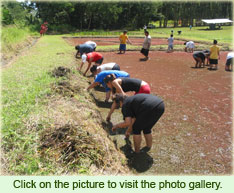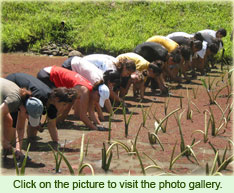
The construction of a lo‘i was not an easy process. Some have noted that if a chief wished to build a lo‘i, the work for him would be easy in that he would have his workers make it for him (Kamakau 1976). However, there were some chiefs who took part in the building of their lo‘i and all the labor that came along with it. For example, Kamehameha, while he was living on O‘ahu “labored himself with his own hands. He worked at the fishponds at Kawainui, Ka‘elepulu, Uko‘a, Maunalua and all about O‘ahu. He made the great taro patches at Waikīkī...” (Kamakau 1992). Lo‘i, however, was not reserved for the chiefs alone. In fact, many maka‘āinana, or commoners, built their own lo‘i and cultivated their own kalo for their families.
Like the construction of a lo‘i, daily maintenance was also hard work. Contrary to popular discussions however, maintaining a lo‘i was not a sun up till sun down process. Daily maintenance took merely four to six hours of the day. During that time, farmers would ensure that the waterways were clear of any debris, ensuring that the water continued to flow through. They would also tend to the lo‘i itself by pulling any weeds out of the lo‘i, ensuring that the embankments are still holding strong, and that the surrounding areas were kept well groomed.
For generations, lo‘i provided the Hawaiian people with a staple food. Kalo, when steamed and pounded made pa‘i ‘ai (hard, pounded, and undiluted taro). When water was added to smooth out the pounded kalo, it became poi. Pa‘i ‘ai could be kept for a while before going bad. Poi did sour much quicker than pa‘i ‘ai, however some people preferred to eat sour poi instead of fresh.
With the influx of foreigners to the islands, evidence of “traditional society” began to fade away while a newer, more “contemporary” culture emerged. In many ways this new way of life took the place of things that were considered, by westerners, as old, primitive, and uncivilized. Unfortunately, kalo cultivation was one practice that sharply declined throughout the 19th century. Many factors contributed to this decline some of which were the introduction of new crops like rice, the loss of land by the maka‘āinana (commoners), the introduction of capitalism, and the urbanization of Hawai‘i.
With the resurgence of Hawaiian culture, many people have participated in the restoration of lo‘i around the islands.

